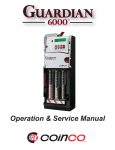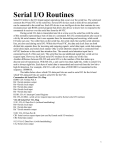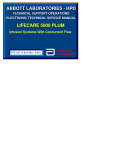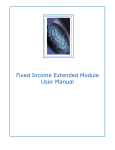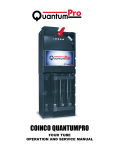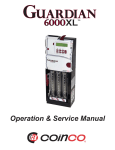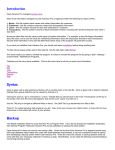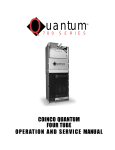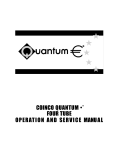Download OPERATION AND SERVICE MANUAL
Transcript
OPERATION AND SERVICE MANUAL Table of Contents Section 1: General Information...................................................................................................... 3 Introduction ................................................................................................................................. 3 Product Overview and Features................................................................................................... 3 Housing Module....................................................................................................................... 3 Acceptor Module...................................................................................................................... 3 Hopper Module ........................................................................................................................ 4 Specifications .............................................................................................................................. 5 Configuration ........................................................................................................................... 5 Input Power Requirements ....................................................................................................... 5 Operating Temperature Range ................................................................................................. 5 Storage Temperature Range ..................................................................................................... 5 Relative Humidity .................................................................................................................... 5 Operating Attitude.................................................................................................................... 5 Physical Dimensions ................................................................................................................ 5 Hopper Capacities .................................................................................................................... 5 Shipping Weight....................................................................................................................... 5 Section 2: Installation .................................................................................................................... 7 Unpacking.................................................................................................................................... 7 Installing the Changer.................................................................................................................. 7 Filling the Hoppers ...................................................................................................................... 7 For Your Records ........................................................................................................................ 8 Section 3: Operation .................................................................................................................... 10 Coin Acceptance........................................................................................................................ 10 Acceptor / Hopper Interface ...................................................................................................... 10 Coin Stirring and Coin Dispensing............................................................................................ 10 Full Hopper Sensing .................................................................................................................. 12 Float Mode................................................................................................................................. 12 Manual Fill Mode ...................................................................................................................... 13 Hopper Coin Counts / Status ..................................................................................................... 13 Indicator LED ............................................................................................................................ 14 Inventory Button Operation / Auto-paydown Mode / Emptying the Hopper............................ 14 Error Handling........................................................................................................................... 14 Section 4: Maintenance................................................................................................................ 16 Routine Maintenance................................................................................................................. 16 Cleaning..................................................................................................................................... 16 Removing / Replacing Individual Assemblies .......................................................................... 16 Acceptor ................................................................................................................................. 16 Hopper.................................................................................................................................... 16 Clearing Coin Jams.................................................................................................................... 16 Section 5: Troubleshooting Guide ............................................................................................... 18 Section 6: Dimensions / Exploded Views / Parts Lists................................................................ 20 Vortex Operation Manual Page 2 of 25 Section 1: General Information Introduction This manual contains information on installing, operating and maintaining a Coinco Vortex model coin changer. This manual is intended for owners, route operators and shop-level technicians as a primary source of information. Taking time to read this manual and becoming familiar with this information will help you obtain the best performance from your Coinco Vortex coin changer. Product Overview and Features The Vortex coin changer consists of three basic modules: • Housing module with power supply and MDB communications interface. • Acceptor module has electronic validation capabilities based on field proven design, and uses active sorting to route deposited coins. • Hopper payout module has self-loading, high capacity compartments to dispense up to three different coin types and payout sensors to ensure coin delivery. • Coin capacity levels are programmable using Float Mode. • Flash programmable memory is used for easy software updates that do not require a chip change. The Vortex coin changer supports only the MDB communication interface. See Figure 1 for a representative MDB vending machine block diagram. Housing Module The Housing Module consists of the Changer Housing, Harness, and the Changer Board. The housing contains three mounting holes for locating the changer in the vending machine, and provides a means to securely position the other modules for proper coin routing and payout. The harness provided meets the requirements of the NAMA MDB Protocol specification. The changer design only supports the MDB protocol. Support for other protocols is not available. The Changer Board provides a convenient interconnect point between the Acceptor Module and the Hopper Module. The Changer Board contains MDB interface circuitry to meet the requirements of the NAMA MDB Protocol specification, and power supply circuitry to convert the unregulated MDB voltage to a nominal 12V for use in the Acceptor and Hopper Modules. A power fail detect circuit can be monitored by the Acceptor Module to detect loss of power and shut down operation in an orderly manner to minimize errors and loss of data. Acceptor Module The Acceptor Module contains circuitry to electronically validate up to 16 different coin types, and accepted coins are actively routed to any of the three Hopper compartments or the cashbox. Rejected coins are automatically returned to the customer. An escrow lever actuates a moveable gate to allow bent coins or other foreign material to be easily removed. The Acceptor Module includes a single LED indicator to provide visual feedback to the operator depending on the current mode of operation. Three inventory buttons are available for the operator to manually Vortex Operation Manual Page 3 of 25 Section 1: General Information inventory the three hopper coin types, and a mode button allows the operator to enter special operational modes as defined in the Operation Section. The Acceptor Module’s plastic design incorporates various physical features to divert fluids, introduced by vandals, away from sensitive electronic components to minimize potential damage. The Acceptor Module contains the majority of the changer’s control logic. In addition to accepting and routing deposited coins, the Acceptor transmits credit and status information to the vending machine and receives control and coin dispense instructions from the vending machine. The Acceptor also directs the Hopper to dispense coins when necessary, and monitors dispense status as well as the coin counts in the three hopper compartments. This includes monitoring each hopper compartment’s Upper Hopper Sensor to know when the compartment is full so that deposited coins may then be routed to the cashbox. Configuration information needed for proper operation is also stored in the Acceptor. Hopper Module The Hopper Module contains three large capacity, self-loading compartments for storing and dispensing up to three different coin types. Hopper A is the left compartment, Hopper B is the center compartment, and Hopper C is the right compartment. Each compartment contains a bidirectional motor to rotate a payout ring in the clockwise direction to “stir” coins and orient them into a “mini-tube” ready to be dispensed. The motor rotates the payout ring in the counterclockwise direction while actuating a payout slide to dispense a coin. Payout sensors verify that coins are actually dispensed. In addition, each compartment contains sensors in the bottom and top to monitor coin counts, and also has its own lid to minimize the possibility of accidentally placing coins into the incorrect compartment during manual loading. Vortex Operation Manual Page 4 of 25 Section 1: General Information Specifications Configuration Vortex Model VTX1 accepts US nickel, dime, quarter, and dollar coins, with the nickel routed to Hopper B, the dime routed to Hopper A, the quarter routed to Hopper C, and the dollar routed to the cashbox. Coins routed to a hopper are automatically routed to the cashbox when the hopper is determined to be full. Input Power Requirements Minimum 20 VDC RMS (Rectified and optionally filtered) @ 1.8A. Nominal 34 VDC unreg (Rectified and filtered) Maximum 42.5VDC (Ripple voltage upper limit) (Per the NAMA MDB Protocol specification.) Operating Temperature Range 0° F to 150° F (-18° C to 65° C) Storage Temperature Range -22°F to 160°F (-30°C to 72°C) Relative Humidity 20% to 95% non-condensing Operating Attitude Vertical ± 3° Physical Dimensions See Section 6 Hopper Capacities Minimum, self-loaded: 180 US nickels, 350 US dimes, 160 US quarters Recommended minimum to actuate low level sensors: 20 US nickels, 30 US dimes, 20 US quarters Shipping Weight Approximately 4 lbs. Vortex Operation Manual Page 5 of 25 Section 1: General Information Controller/Vendor Interface VTX MDB Coin Changer Plug Figure 1 Vortex Operation Manual Page 6 of 25 Section 2: Installation Unpacking After removing the unit from the shipping carton, inspect it for possible shipping damage. If the unit is damaged, notify the shipping company immediately. Only the consignee (the person or company receiving the unit) can file a claim against the carrier for shipping damage. We recommend that you keep the original carton and packing materials to reuse if you need to transport or ship your changer in the future. If the coin changer is being stored or used as a spare, always keep it in its shipping carton when not in use. This will keep it clean and offer the best protection for the unit. Installing the Changer 1. Remove the power from the vending machine. 2. Remove the Acceptor from the Changer housing by lifting the hopper release lever (see Figure 2) on the front of the Acceptor, and pulling the top of the Acceptor forward, away from the Changer housing. Disconnect the Acceptor’s ribbon cable from the Changer Board. Lift the Acceptor slightly to free the lower acceptor studs from the Changer housing. Place the Acceptor in a clean area. 3. Remove the Hopper from the Changer housing by pulling the top of the Hopper forward, away from the Changer housing. Disconnect the Changer Board’s ribbon cable from the top of the Hopper. Lift the Hopper slightly to free the lower hopper studs from the Changer housing. Place the Hopper in a clean area. 4. With the Acceptor and Hopper removed, set the mounting holes in the back of the Changer housing over the mounting screws in the vendor, then lower the housing so the mounting screws are in the retaining slots. Tighten snugly. 5. Load coins into the Hopper. See FILLING THE HOPPERS section. 6. Install the Hopper by inserting the lower hopper studs into the Changer housing guides. Connect the Changer Board’s ribbon cable to the top of the Hopper. Press the top of the Hopper into the Changer housing. Insure the ribbon cable lays behind the changer. 7. Install the Acceptor by inserting the lower acceptor studs into the Changer housing guides. Connect the Acceptor’s ribbon cable to the Changer Board. Press the top of the Acceptor into the Changer housing. Insure the Hopper release lever slides down into the locked position. 8. Connect the Changer harness to the vendor. 9. Verify the vendor’s coin return mechanism is adjusted so that the Acceptor gate is fully closed. When the vendor’s coin mechanism actuates the Acceptor escrow lever, the leading edge of the Acceptor gate must open by at least 0.150”. 10. Apply power to the vendor. Note: every time power is applied, the changer will stir all three payout rings to establish the presence of coins. 11. Use the inventory buttons to dispense a few coins from each hopper compartment. This helps the changer establish an approximate coin count. 12. Test the changer with a variety of coins to ensure proper operation. Vortex Operation Manual Page 7 of 25 Section 2: Installation Filling the Hoppers Top Load Lift the hopper release lever and pull the hopper forward. Open a single hopper lid by releasing the black snap located at the front of each hopper. Note: This operation opens both the sensor cover and the hopper lid. To minimize mis-loading, do not open more than one hopper lid at a time. Fill the hopper to the desired level, snap the lid closed and repeat the process for each coin type. Do not overfill! An indication of overfill is the need to force the hopper lid down so that it snaps in place. When finished filling all of the hoppers, secure the sensor cover (over the hopper lids) and press the hopper back into the changer housing. Insure the hopper release lever is down in the locked position. Bench Top Load The hopper assembly may be removed by lifting the hopper release lever and pulling the hopper assembly forward to the stops. Disconnect the hopper harness and lift the hopper assembly up and out. Continue by following the Top Load instructions above. Front Load Each hopper can be loaded by inserting coins through the openings in the front of the hopper. Acceptor Load The Manual Fill Mode allows coin loading through the acceptor to fill the hoppers. No credit is established in Manual Fill Mode. To enter the Manual Fill Mode, press the 25¢ inventory button and the blue Mode button at the same time. The acceptor LED will flash an equal pattern of ON and OFF to indicate that this mode is activated. Coins inserted through the acceptor will be routed to the appropriate hopper. To exit the Manual Fill Mode, press the blue Mode button or coin return lever. For Your Records A label indicating the changer’s model number and serial number can be found on the side of the coin changer. Refer to the model number and serial number whenever you call your Coinco Service Center for information or service. The first four digits of the changer serial number indicate when the unit was built which is also the beginning of the warranty period. The first two digits indicate the week of manufacture; the third and fourth digits indicate the year of manufacture. For example, Serial Number 2303000123 indicates the unit was manufactured in the 23rd week of 2003. The model number indicates special changer options, if any, such as programming to accept certain tokens. Vortex Operation Manual Page 8 of 25 Section 2: Installation 7 1 5 4 3 2 6 Figure 2 Item 1 2 3 4 Description LED Indicator Inventory Button – Left Hopper (10¢) Inventory Button – Center Hopper (5¢) Inventory Button – Right Hopper (25¢) Vortex Operation Manual Item 5 6 7 Description Mode Button Hopper Release Lever Escrow Lever Page 9 of 25 Section 3: Operation Coin Acceptance Deposited coins enter the coin inlet funnel, where they are directed down a coin rail formed by the mainplate and the escrow gate. Optical and magnetic sensors are positioned along the rail to validate coins. When a coin reaches the end of the coin rail, it will drop into the coin reject chute for return to the customer, unless the “accept” solenoid is energized to open the first diverter gate to accept the coin. When the changer has no power, deposited coins are directed to the reject chute for return to the customer. Accepted coins will go to the cashbox chute unless they are actively routed to the hopper by energizing at least one of the remaining two solenoids. The specific hopper is determined by which solenoid, or combination of solenoids, is energized. The escrow lever actuates the escrow gate to serve two purposes. Pressing the escrow lever physically opens the escrow gate to dislodge bent coins and foreign materials, allowing them to fall into the coin reject chute. If the escrow gate opens, the movement is detected by the changer electronics and communicated to the vending machine controller causing customer credit to be paid back. If coins are deposited too closely together, one or both coins may be rejected if the changer cannot safely route them to their appropriate hopper. When any object (coin, fraud, etc) is rejected, the changer automatically delays approximately one second before coin validation begins again to allow the rejected object to exit the system. Acceptor / Hopper Interface The Acceptor and Hopper communicate with each other. The Acceptor can request coin count and other status information from the Hopper, in addition to instructing the Hopper to stir or dispense coins. To keep the interconnection simple and modular, the communication line is routed through the Changer board where power supply lines are added. Multiple power and ground lines are used to provide the maximum amount of power to the Hopper when needed. If a power or ground conductor is broken, the system may appear operational, but performance can suffer under high load conditions that may occur when stirring or dispensing coins. Coin Stirring and Coin Dispensing The Hopper PCB Assembly communicates coin count and status information to the Acceptor and also controls the stir and payout operation under the direction of the Acceptor. The Hopper PCB may energize the bi-directional motor to rotate the payout ring in the clockwise direction to stir coins for approximately one second in an attempt to load a coin into the payout ring and also to update the coin count in case coins have been deposited manually. A stir will automatically return a payout slide to its “home” position, but will not cause a coin payout. When a hopper stirs or dispenses a coin, the Hopper PCB monitors coin contact with the base hopper contacts to develop an approximate coin count. This information is transmitted to the Acceptor where it is used in an algorithm to determine the actual coin count reported to the vending machine controller. The individual hoppers are stirred in the sequence Hopper A, Hopper B, Hopper C, Vortex Operation Manual Page 10 of 25 Section 3: Operation but the hoppers are only stirred if necessary. The Acceptor requests the Hopper stir the individual hoppers under the following conditions: 1. At power up the hoppers are each stirred twice in the sequence Hopper A, Hopper B, Hopper C, Hopper A, Hopper B, Hopper C. The stirs are delayed approximately four seconds to minimize power usage in case a bill acceptor is in the system and performing its initialization which usually includes a bill stack operation that may require a significant amount of current. Two stirs are sufficient to identify whether a hopper contains a few coins, or no coins, but up to 10 stirs are required to identify whether a hopper contains many coins. Generally, two stirs provide sufficient information for the changer to report coin counts that allow a vending machine controller to enable acceptance of some larger denomination coins, and small denomination bills. However, 10 or more stirs may be required for the Vortex to identify coin counts sufficient to enable acceptance of larger bill denominations. 2. A hopper will be stirred periodically when the base hopper contacts detect few or no coins approximately 5 minutes after power up, or any potential customer activity (coin deposit or coin dispense, then approximately every 60 minutes of inactivity thereafter. 3. A hopper previously empty, or low on coins, will be stirred approximately 1 minute after the base hopper contacts suddenly detect a change in the number of coins. This is generally an indication coins were manually loaded. 4. A hopper will be stirred upon exiting auto-paydown mode. (See the discussion on autopaydown mode later in this document.) 5. A hopper will be stirred upon exiting manual fill mode if 10 or more coins were deposited during manual fill. (See the discussion on manual fill mode later in the document.) A coin dispense sequence consists of the following steps as required: 1. The Hopper PCB energizes the bi-directional motor to rotate the payout ring in the counterclockwise direction and simultaneously actuate the associated payout slide 2. The payout slide moves from its “home” position to a position where it can load a coin from the payout ring, and then back to the home position. The Hopper PCB monitors a magnet in the payout slide to stop the slide in the home position. 3. After the motor is de-energized with the slide in the home position, the Hopper PCB monitors one of two sense coil assemblies that are used as payout sensors. The payout sequence is considered complete if the payout sensor detects a coin. 4. The Hopper PCB will repeat the sequence a second time if a coin payout was not detected. Please note the Vortex will not dispense a coin on every dispense cycle. But if no coin payout is detected, the Vortex will attempt again. 5. If the payout sensor fails to detect a coin after the second attempt, the Hopper PCB will stir the coins. Then the Vortex repetitively attempts the “pay”, “pay”, “stir” sequence for approximately 10 seconds, or until a coin is sensed by the payout sensor. 6. If no coin payout is detected for approximately 10 seconds, the Hopper PCB will “time out” and inform the Acceptor that no coin was dispensed. If the Hopper’s coin dispense attempt is not successful, the Acceptor may re-issue the coin dispense command, or the Acceptor may request that alternate coins be dispensed. To minimize a potential vending machine power supply conflict, stir and payout attempts may be interrupted and then continued, approximately four seconds later, if a bill acceptor command is detected that could cause a bill stack operation. For example, if an appropriate bill acceptor Vortex Operation Manual Page 11 of 25 Section 3: Operation command was detected during the power up stir sequence, the sequence might be Hopper A, Hopper B, delay, Hopper B, Hopper C, Hopper A, Hopper B, Hopper C, or something similar where there is a delay before the stir sequence continues. This is normal operation and to be expected. The Hopper A slide may temporarily partially block the coin reject chute during a coin payout, and the Hopper C slide may temporarily partially block the cashbox chute during a coin payout. Consequently, if a coin payout from Hopper A is in process when another coin is deposited, the payout will be interrupted when the slide reaches the home position for approximately two seconds to allow the rejected coin to exit the changer. The payout operation will then continue if necessary. If the power failure circuitry detects a power failure during a payout attempt, the changer will automatically attempt to return the payout slide to the home position so the coin reject chute will not be blocked during the power outage, thus allowing deposited coins to be returned. The Vortex changer supports the optional “Alternative Payout” MDB Level 3 command in addition to the standard Level 2 “Dispense” command. Dispense commands are internally buffered in the changer in case the vending machine controller issues them faster than the changer can dispense the corresponding coins. The coin dispense sequence may not always be highest denomination to lowest denomination because of the way the Dispense commands are buffered, or due to various “alternative payout” sequences that may be used depending on the Acceptor’s counts for the various coin denominations. However, the customer should receive the proper amount of change, provided the change is available. Due to the nature of a hopper based payout mechanism, several coins may remain in the hopper when it reports a count of 0. This reduces potentially lengthy delays that may occur during attempts to dispense the last few coins in a hopper. It is not unusual to see as many as 10 small diameter coins remaining in the hopper when it is reported to be empty. Fewer larger diameter coins remain in the hopper when the count is 0. Full Hopper Sensing Upper hopper magnetic sense coil assemblies are used to determine whether the three individual hoppers are full by sensing if coins are standing up in the coin inlets at the top of the hopper. At the time of manufacture, the Acceptor stores a “not full” value corresponding to the absence of a coin at the sense coil assembly. When the sense coil assembly reading differs significantly from this reference value, the hopper is considered full and future deposited coins of that type are routed to the cashbox. If a new Hopper is installed in a changer, the Acceptor initially flags each hopper compartment as full until 10 coins have been dispensed from the compartment. Then, the “not full” reference value is stored. Prior to dispensing 10 coins from the compartment, if the base hopper contacts detect few or no coins, the upper hopper magnetic sense coil reference value will be stored immediately. Float Mode The operator can use the inventory buttons and mode button to enter float mode and set the desired level of change to be individually maintained in each of the three hoppers. Once this Vortex Operation Manual Page 12 of 25 Section 3: Operation mode is set, the Acceptor will route a coin into the associated hopper for every coin that has been dispensed from that hopper. Additional deposited coins will be routed to the cashbox. Enable float mode by simultaneously pressing the left inventory button and the mode button for approximately 1 second, then release those buttons and simultaneously press the center and right inventory buttons for approximately 1 second. After the left inventory and mode buttons are pressed, the visible LED will blink at an approximate 1Hz rate, 10% duty cycle (the LED is “off briefly, then “on” for the majority of the time), until the center and right inventory buttons are pressed. While float mode is enabled, the visible LED will blink at a rate of approximately 1 Hz, 90% duty cycle (the LED is “on” briefly, then “off” for the majority of the time). To disable float mode, repeat the original procedure used to enable it. The visible LED will stop blinking, indicating float mode is no longer active. If only the left inventory and mode buttons are pressed, the changer will automatically return to normal mode after approximately ten seconds, and the LED will stop blinking. While float mode is enabled, the Vortex will attempt to maintain the number of coins in all hoppers at the level established when float mode was initially enabled. Coins will not be routed to the respective hopper to replenish it, unless one or more coins have been dispensed from the hopper. When initially enabled, each hopper’s float count is cleared. The Vortex attempts to maintain the counts at zero by decrementing them for each coin dispensed, and incrementing them for each coin deposited. As long as sufficient coins are being deposited to replenish the hoppers, the quantity of coins in the hopper should be maintained. If coins are manually loaded into the hopper without re-initializing float mode, the Vortex will still route coins to the appropriate hoppers until the float count is zero, so the actual float level setting will then be higher than when initially set. If the hopper coin level is too low when float mode is enabled, the Vortex will route coins to the hopper until it meets the minimum acceptable level, typically 10 to 20 coins. Float Mode is automatically cleared when a different Hopper is connected, or if the internal configuration information is determined to be bad. Manual Fill Mode Manual fill mode may be used by the operator to route coins to the Hopper through the Acceptor, without establishing any credit on the vending machine. This helps the coin changer and vending machine keep a more accurate count of coins available for change. Press the right inventory button and the mode button at the same time to enable manual fill mode. While manual fill mode is active, the visible LED will blink at a rate of approximately 1 Hz, 50% duty cycle (the LED blinks “off” and “on” for about the same amount of the time). The acceptor will automatically enable acceptance of all hopper coins while manual fill mode is active. If no coins are dropped for approximately 45 seconds, or if the escrow lever or mode button is pressed, manual fill mode is exited. Depending on the type of vending machine controller, the Vortex may reset when manual fill mode is exited. Hopper Coin Counts / Status Each Hopper compartment has two base hopper contacts that are used to determine an approximate coin level in the compartment when the coins are stirred or dispensed. If the Vortex Operation Manual Page 13 of 25 Section 3: Operation compartment is very low on coins, the contacts may detect coins that are manually deposited into the hopper so the status may be sent to the Acceptor. The approximate coin level and hopper status information is communicated to the Acceptor so that a coin count may be established and reported to the vending machine controller. Indicator LED The indicator LED on the Acceptor provides visual feedback to the operator depending on the state of the changer as follows: 1. The indicator LED is on continuously to indicate power is applied to the changer. 2. The indicator LED will blink momentarily while deposited coins are passing through the Acceptor to indicate they are being validated. 3. When the changer is in float mode, the LED will blink at the rate defined in the Float Mode section. (The LED is “on” briefly, then “off” for the majority of the time.) 4. When the changer is in manual fill mode, the LED will blink at the rate defined in the Manual Fill Mode section. (The LED blinks “off” and “on” for about the same amount of time.) Inventory Button Operation / Auto-paydown Mode / Emptying the Hopper Coins may be dispensed individually from each hopper compartment by momentarily pressing the corresponding white inventory button for the compartment. The left inventory button corresponds to the left hopper, the center inventory button corresponds to the center hopper, and the right inventory button corresponds to the right hopper. When an inventory button is momentarily pressed, the changer will attempt to dispense a coin from the corresponding compartment. The dispense sequence will automatically stop after a coin is sensed as having been dispensed, or after an approximate 10 seconds of unsuccessful dispense activity. Multiple coins may be dispensed by continuously pressing an inventory button until the desired number of coins has been dispensed. If an inventory button is continuously pressed and five coins dispensed, the changer will enter auto-paydown mode where the inventory button may be released while the changer continues to dispense coins. Auto-paydown mode ends after approximately 10 seconds of unsuccessful dispense activity, or after the escrow lever or mode button is momentarily pressed. The changer may need to be tilted backwards to help the last few coins in the hopper compartment into the payout ring so they may be dispensed. Alternatively, the Hopper may be turned upside down to manually empty the remaining coins. Please note inventory button operation may be inhibited by the vending machine controller, typically to manage power usage during a vend cycle. However, some vending machine controllers normally inhibit inventory buttons, only enabling them when in service mode. Error Handling The Vortex changer is capable of detecting several types of potential internal errors, and may continue to operate, although with reduced functionality when they occur. The following error conditions deserve specific discussion. Vortex Operation Manual Page 14 of 25 Section 3: Operation 1. The changer will report a “jammed” hopper to the vending machine controller when there is physical jam in the payout ring, the payout slide, or near the payout sensor, or if an error is detected with the slide home sensor or the payout sensor. A jam is also reported if an individual hopper compartment accumulates over 30 seconds of unsuccessful payout activity while there are many coins in the compartment. A jam causes the specific compartment to be taken off-line so the changer will no longer attempt to dispense coins from the jammed compartment. Other compartments still capable of dispensing coins may be used to dispense coins even though one compartment is jammed. When the source of the jam is corrected, the operator must use the appropriate inventory button and successfully inventory a coin from the compartment in order to clear the internal error flag and allow normal operation to resume. The changer only attempts to dispense change from the compartment after the error flag is cleared. 2. If the input voltage to the changer is too low for reliable operation, the changer will report to the vending machine controller that no coins are available for change. Then coin acceptance will be inhibited and the unit will not attempt to stir coins in the hopper, or to dispense coins. When the input voltage is capable of supporting reliable operation, the changer will reset and resume normal operation. 3. If the Acceptor is no longer able to communicate with the Hopper, all coin acceptance is inhibited. Vortex Operation Manual Page 15 of 25 Section 4: Maintenance Routine Maintenance Routine maintenance will improve performance and extend the life of your Vortex changer and reduce the need for more involved repairs. Frequency of maintenance will depend on environment and number of transactions. The coin changer should be kept in its original shipping carton when not in use. This will keep the changer clean and offer the best protection for the unit. Cleaning The majority of your Vortex changer is manufactured from a high-quality industrial grade plastic and should only be cleaned with a warm water and mild detergent solution. Caution: • Never submerge changer in water. • Do NOT use petroleum solvents, steel wool, scouring pads, or metal brushes for cleaning. • Do not spray any part of the changer with any type of lubricant. Since all coins share a common coin inlet ramp, heavy usage or a dirty environment can result in dirt build-up in the acceptor. Clean the coin ramp by lifting the acceptor gate upward and diagonally to the right. Hold the gate to prevent it from snapping back. Wipe the exposed coin ramp and inner surfaces with a damp cloth. For excessively dirty units, use a damp cloth and mild detergent. DO NOT SUBMERGE UNIT IN WATER. Removing / Replacing Individual Assemblies Acceptor Remove the Acceptor from the Changer housing by lifting the hopper release lever on the front of the Acceptor, and pulling the top of the Acceptor forward, away from the Changer housing. Disconnect the Acceptor’s ribbon cable from the Changer Board. Lift the Acceptor slightly to free the lower acceptor studs from the Changer housing. Place the Acceptor in a clean area. Hopper Remove the Hopper from the Changer housing by pulling the top of the Hopper forward, away from the Changer housing. Disconnect the Changer Board’s ribbon cable from the top of the Hopper. Lift the Hopper slightly to free the lower hopper studs from the Changer housing. Place the Hopper in a clean area. Clearing Coin Jams To clear coins jammed in the cashbox chute, remove the Hopper. Jammed coins should then fall out. Vortex Operation Manual Page 16 of 25 Section 4: Maintenance To remove coins jammed in the Acceptor, unsnap the Front Intermediate Assembly Cover and remove it to expose the coin path. Jammed coins should either fall out or be visible and accessible if trapped at one of the routing gates. Snap the Front Intermediate Assembly Cover back in place after the jam is cleared. Perform the following procedure to remove coins jammed in a payout ring: 1. Remove all loose coins from the Hopper. 2. Remove the 2 6-32X3/8 screws from the lower front of the hopper. This allows the hopper to tilt back allowing access to the jammed coins. 3. Note the color of the payout ring in each hopper compartment. The color identifies the coin type for that compartment. If the payout rings are installed in the wrong compartment, payout problems will result! 4. Clear the jammed coins. Remove the payout ring, if necessary, by pulling it out. 5. Reassemble the Hopper in the reverse order. If any payout rings were removed, be sure they are fully seated before fastening the hopper to the payout base. Otherwise, the rings may be jammed between the hopper and payout base, and unable to rotate. Also insure the harnesses on the back of the Hopper are routed properly so they are not pinched between the hopper and the payout base. Vortex Operation Manual Page 17 of 25 Section 5: Troubleshooting Guide Trouble No coin acceptance Possible Cause No Power Verify visible LED on acceptor gate is “on” or blinking when power is present. VMC has coin acceptance disabled VMC should be in sales mode Hopper No coin acceptance or rejects high percentage of good coins Accepts coins but gives no/or erratic credit Coin return lever Contamination Acceptor Acceptor Changer Board Hopper New Hopper or New Acceptor Accepted coins always route to cashbox Procedure Hopper Contamination Changer Board Acceptor Hopper No payout attempt Changer Board Acceptor If Hopper does not stir at power-up and manual inventory buttons do not work Make sure changer is mounted correctly and coin return lever is not partially depressed. Remove front cover and check to see that acceptor coin and sort path are clean and free of foreign matter. If still rejects good coins … Replace with good acceptor and test Replace with good changer board and test Replace with good hopper and test When the unit is powered up with a different hopper or acceptor and coins are Already in the unit … When the unit is powered up with a different hopper or acceptor and coins are not already in the unit … Hopper does not stir at power-up. Manual inventory buttons do not work Replace with good hopper and test Remove front cover and check to see that acceptor sort path is clean and free of foreign matter. Replace with good changer board and test Replace with good acceptor and test Hopper does not stir at power-up. Manual inventory buttons do not work Replace with good hopper and test Replace with good changer board and test Replace with good acceptor and test Check for an incorrect coin in problem hopper Payout attempted but coin is not paid Hopper Vortex Operation Manual Motor runs, slide moves up and down, ring turns, coins move freely, but coins still don’t pay. Coins do not move freely when ring turns Replace with good hopper and test Remedy Plug changer into vendor. Tilt out acceptor and insure it is plugged into changer board. Replace MDB harness Replace changer board Replace Acceptor VMC may disable coin acceptance in service mode, sometimes when the door is opened. Plug changer board cable into hopper lid board. Reposition changer and/or vendor coin return lever. Follow cleaning procedure described in manual. Replace Acceptor Replace Acceptor Replace changer board Replace hopper Dispense 20 coins from each hopper, wait 20 sec. for upper hopper sense coil initialization wait 20 sec. for upper hopper sense coil initialization Inspect 4 position connectors on hopper lid board. Plug in if disconnected. Replace hopper Follow cleaning procedure described in manual. Replace changer board Replace Acceptor Inspect 4 position connectors on hopper lid board. Plug in if disconnected. Replace hopper Replace changer board Replace Acceptor Remove coins and eliminate incorrect coinage. (e.g. found a nickel in dime hopper) Clear contamination from slide/ring area Dislodge coins from ring. Replace hopper Page 18 of 25 Vortex Operation Manual Page 19 of 25 Section 6: Dimensions / Exploded Views / Parts Lists VORTEX DIMENSIONAL VIEWS (All Measurements Shown in Inches) Vortex Operation Manual Page 20 of 25 Section 6: Dimensions / Exploded Views / Parts Lists 3 2 1 ITEM PART # PART DESCRIPTION QTY. NOTES 1 2 3 VTX1 408292 408293 408531 VORTEX CHANGER PAYOUT ASSY, VORTEX ACPTR ASSY,VORTEX HSG ASSY,VORTEX 1 1 1 Includes harness and changer board Vortex Operation Manual Page 21 of 25 Section 6: Dimensions / Exploded Views / Parts Lists 3 2 1 ITEM 1 2 3 PART # 408531 408017 925191 407006-4 Vortex Operation Manual PART DESCRIPTION HSG ASSY,VORTEX PCB ASSY,CHGR BD VORTEX HSG,CHGR VORTEX HRNS QTY. 1 1 1 Page 22 of 25 Section 6: Dimensions / Exploded Views / Parts Lists 13 16 15 5 29 23 18 2x 7 22 3 2 10 9 28 6 3x 2 30 3x 1 13 19 27 11 1 26 31 24 8 33 20 12 2 30 5 15 17 25 4 28 21 14 408293 Vortex Acceptor Assembly Vortex Operation Manual Page 23 of 25 Section 6: Dimensions / Exploded Views / Parts Lists ITEM 1 2 3 4 5 6 7 8 9 10 11 12 13 14 15 16 17 18 19 20 21 22 23 24 25 26 27 28 29 30 31 32 33 PART # 408293 296P6R10 345-4R5 406613-1 407615-1 407825-4 407981 408007 408016 408305 408306 408510 408511 408512 408533 408540 908845-1 923995 925159-1 925177 925180 925183 925186 925187 925188 925189 925226 925233 925288 925299 925300 925387 925561 921474 Vortex Operation Manual PART DESCRIPTION ACPTR ASSY,VORTEX SCREW,6X5/8 PH PHIL TYPE25 BLK SCREW,4X5/16 PH PHIL PLAS COIL ASSY,SNS PLUNGER & YOKE ASSY TAU COIL & POT CORE SOLENOID & 'C' FRAME ASSY PCB ASSY,ACPTR LOGIC VORTEX PCB ASSY,ACPTR GATE VORTEX PLUNGR ASSY,ACPT/REJ LNK PLUNGR ASSY,LFT/RT VORTEX GATE ASSY,VORTEX CVR,GATE W/LENS MAINPLATE,W/GRATE & SRT VORTEX CVR,FRONT INTER ASSY VORTEX MAG WIRE & COIL ASSY PLUG,SPRING RETENSION LBL,ACPTR BAR CODE LED, IR T1 LEVER,ESCROW VORTEX GATE,ACPT/REJ SRT VORTEX GATE,FRT/BK SRT VORTEX CVR,ACPTR REAR VORTEX BRKT,COIL MAINPLATE VORTEX PLATE,DEBOUNCE VORTEX SPRING,ACPT/REJ VORTEX KEYPAD,VORTEX SPRING,ESCROW VORTEX SPRING,FRONT BACK SOLENOID FOAM,MAINPLATE CORES FOAM,GATE CORES WASHER,ESCROW LEVER VORTEX DECAL, VORTEX TAPE, CLEAR 3/4 WIDE QTY. 2 3 1 1 2 3 1 1 1 1 1 1 1 1 2 1 1 2 1 1 1 1 1 1 1 1 1 2 2 5 1 1 1 Page 24 of 25 Section 6: Dimensions / Exploded Views / Parts Lists 20 6 16 17 3 12 2x 13 4 2x 25 18 2 2x 26 8 23 5 9 21 6x 7 1 14 3 2x 22 24 15 3x 10 19 11 ITEM 1 2 3 4 5 6 7 8 9 10 11 12 13 14 15 16 PART # 408292 116-6R6 345-2R3 345Y4R10 406613-1 407398-7 408019-1 408297 408297-1 408297-2 408503 408509 408515 408517 408572 408988 408999-1 Vortex Operation Manual PART DESCRIPTION PAYOUT ASSY, VORTEX SCREW,6-32X3/8 PH PHIL SCREW,2X3/16 PH PHIL PLAS SCREW,4X5/8 PH PLAS 48-2 COIL ASSY,SNS HRNS,POWER TO LWR HOPPER PCB ASSY,HOPPER VORTEX SLIDE ASSY,VORTEX .25, W/ MAGNET SLIDE ASSY,VORTEX .10, W/ MAGNET SLIDE ASSY,VORTEX .05, W/ MAGNET PAYOUT,BASE ASSY VORTEX HRNS,LWR HOPPER W/TERM HSG,VORTEX PCB W/FOAM CVR ASSY,HOPPER VORTEX HOPPER, W/SILICONE VORTEX MOTOR AND GEARBOX ASSY ASSY, VORTEX DIME DOOR & LBL QTY. 2 2 4 2 2 1 1 1 1 1 1 1 1 1 3 1 Page 25 of 25 Section 6: Dimensions / Exploded Views / Parts Lists ITEM 17 18 19 20 21 22 23 24 25 26 PART # 925568-1 408999-2 925568-2 408999-3 925568-3 925170 925201 925227 925328 925329 925330 925400 925546 Vortex Operation Manual PART DESCRIPTION LBL, VORTEX DIME DOOR ASSY, VORTEX NICKEL DOOR & LBL LBL, VORTEX NICKEL DOOR ASSY, VORTEX QUARTER DOOR & LBL LBL, VORTEX QUARTER DOOR MOUNT,MOTOR VORTEX CVR,PAYOUT REAR VORTEX CONTACT,BASE HOPPER VORTEX RING,NICKEL VORTEX RING,DIME VORTEX RING,QUARTER VORTEX DIVERTER,COIN VORTEX PIN, VORTEX HINGE QTY. 1 1 1 1 6 1 1 1 1 1 Page 26 of 25


























